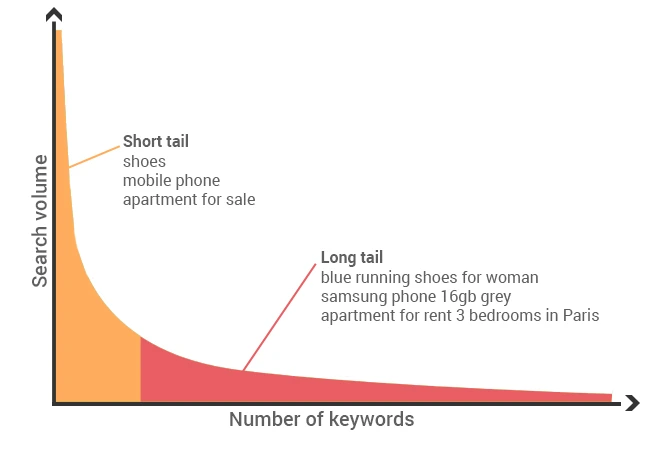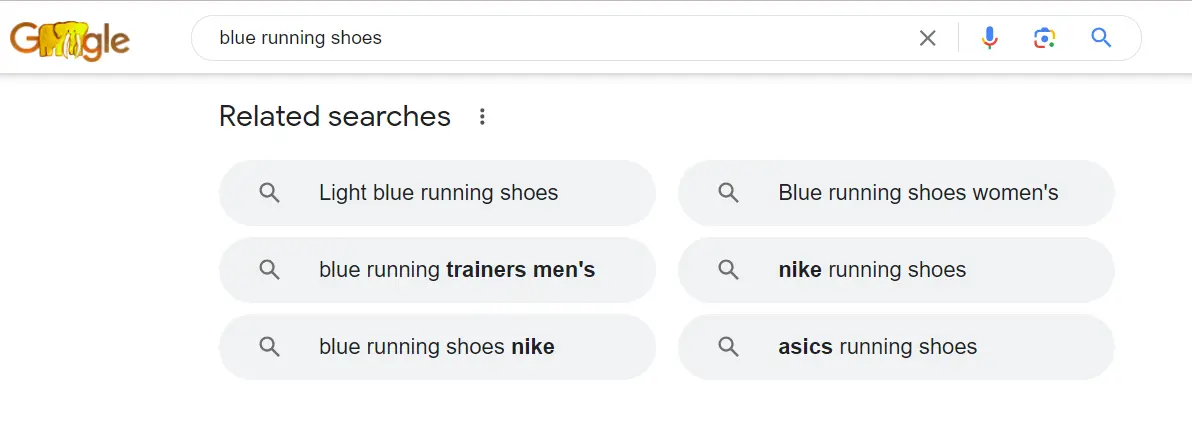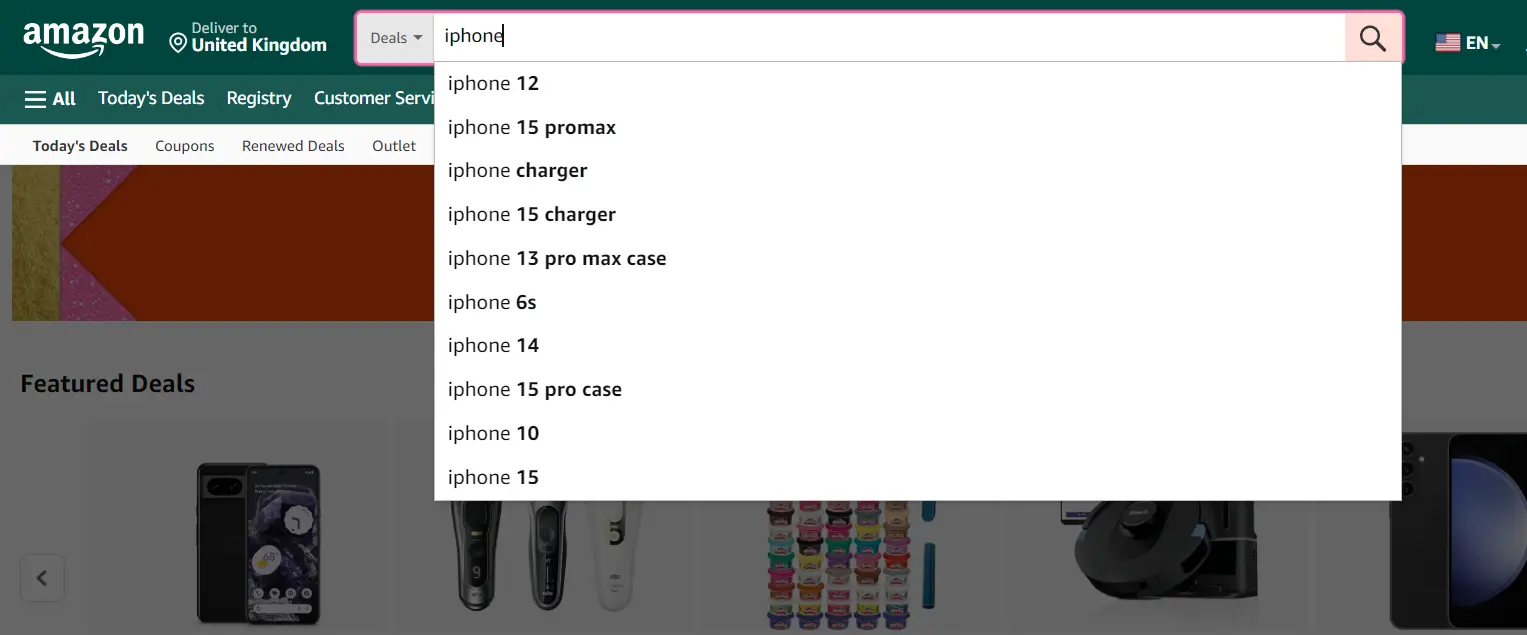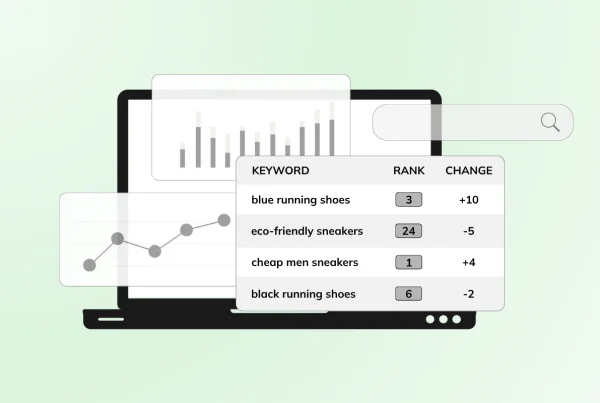Blog article
Best 10 Long-Tail Keywords Software for eCommerce (2025)
Estimated reading time: 7 minutes

What Are Long-Tail Keywords?
In eCommerce, long-tail keywords represent all the different ways search engine users express their product needs and buying intentions.
Each long-tail keyword reflects a specific type of intent – be it
– informational, where users are seeking guidance about products;
– navigational, where they are looking for a specific website or brand; or
– transactional, where the intent is to buy.
Unlike short-tail or search queries that refer to broad topics, long-tail keywords are more specific and often less competitive, yet effective in driving targeted traffic. This makes them invaluable for eCommerce sites.

Keyword research for eCommerce
When you know what your audience searches for, you can focus your optimisation efforts around those keywords. And since consumer demand is ever changing and product offerings evolve, so do the search terms used. Therefore, regular keyword research ensures you capture more demand opportunity, aligning your offerings with the latest search trends.
Keyword research can help you understand which content you should incorporate in your website. It also provides you with information on how to expand your category hierarchy.
Since research shows that, in eCommerce, 70% of non-branded SEO traffic is landing on category pages, it’s important to have a deep category tree with many subcategories as this will make it easier for search engines to find indexed pages from your store that match with search terms.
Boost your eCommerce organic visibility: Why You Should Create More Category Pages.
Why Are Long-Tail Keywords Important?
Long-tail keywords, typically consisting of several words, offer a high degree of specificity. This specificity greatly benefits eCommerce websites and their potential customers.
With long-tail queries, online stores receive traffic that is more closely aligned with the products they sell, which will improve their ability to convert visitors to buyers.
Visitors are more likely to find the products they are looking for when they use long-tail search terms.
Take, for example, an eCommerce site specializing in outdoor gear. A user searching for:
“waterproof hiking backpacks under $100”
is already expressing a clear intent to purchase, as opposed to a more general search like:
“backpacks.”
The long-tail search not only directs the user straight to the relevant product or category, but also significantly increases the chance of a sale.
Long-tail keywords face less competition in search rankings than broader terms (short-tail). This reduced competition means it could be easier to rank higher in search results for these specific queries, driving targeted traffic growth and enhancing your long-tail SEO strategy for your eCommerce site.
Long-Tail Keywords in eCommerce
Long-tail keywords, often overlooked in favor of more popular terms, hold the potential to drive significant and relevant traffic to eCommerce sites. Their importance cannot be understated, as they bridge the gap between what customers are specifically looking for and the products that stores offer.
The main reasons why these keywords are overlooked in eCommerce is because creating pages or product content that is perfectly tailored for the different ways in which users use language to describe the products they search is difficult. It’s time consuming to make deep category hierarchies in modern eCommerce CMS’s, especially when product catalogs become large. The other reason is that it’s difficult to produce great, helpful content for the long-tail at scale.
The challenge of producing great, tailored content for long-tail keywords in eCommerce is further compounded by the dynamic nature of both product catalogs and consumer trends. On the supply side, eCommerce businesses frequently update their product offerings to stay competitive and meet market demands. This constant evolution of product catalogs means that the keywords relevant today might not be as pertinent tomorrow. As new products are added and others are discontinued, the associated long-tail keywords need to be continually identified, analyzed, and integrated into the site’s content strategy. This ongoing process requires significant resources in terms of time, technology, and manpower to ensure that the content remains relevant and effective.
On the demand side, consumer trends and search behaviors are equally fluid. The way consumers search for products online is influenced by many factors, including cultural trends, marketing campaigns, seasonal demands, and even global events. This results in a continuously shifting landscape of keywords and search terms. For an eCommerce business, keeping up with these changing trends is vital to remain visible and relevant in search results. However, the task of constantly monitoring and adapting to these shifts in consumer behavior can be overwhelming, especially for businesses with limited resources.
Balancing the ever-changing landscape of products and consumer trends poses a significant challenge for eCommerce sites striving to leverage long-tail keywords and their SEO eCommerce strategies effectively.
Cheaper Pay Per Click (PPC) Advertising
Long-tail keywords are typically longer, more precise, and consequently more affordable. These keyword phrases are used in PPC campaigns because of their low search volume and lower cost-per-clicks (CPCs). They’re more specific and attract highly targeted, purchase-ready customers. Using long-tail keywords allows for effective budget distribution in PPC campaigns since targeting high volume, short keywords can be relatively expensive. The reduced competition and lower CPC of long-tail keywords make them ideal for PPC, lowering the cost-per-click and cost-per-lead, and improving click-through rates and quality scores.
Lower competition
Long-tail keywords have less competition because they are used in niche-specific searches with relatively low search volume. This means that these keywords are only used by particular groups of people, and not many businesses invest in them for their content or PPC campaigns. Long-tail keywords are easier to rank in organic searches and are valuable for paid search marketing campaigns. Their specificity results in only a few businesses targeting these keywords, which makes ranking easier in both organic and paid searches.
Targeted Traffic
Long-tail keywords are more specific and are often used by people further down the conversion funnel. This specificity brings more targeted traffic to websites, which tends to convert better compared to traffic from shorter keywords. Long-tail keywords are more aligned with how users search online. While they may not bring as much traffic as popular keywords individually, collectively they account for a significant portion of online searches. The traffic drawn by long-tail keywords is more focused and committed, thereby improving the quality of visitors.
High Conversion
Long-tail keywords typically have higher conversion rates due to their specificity. Users searching with these keywords are often further along in the buying cycle, indicating a clearer purchase intent. For instance, a keyword like “keto diet” is broad and attracts a general audience, whereas a long-tail variant like “keto diet meal plan for beginners” targets users with a specific need. Users in the final stages of the buying cycle are more likely to use relevant keywords such as long-tail variants to find something specific and then make a purchase, leading to higher conversions for eCommerce websites.
Launch Pages Automatically with the Keyword Tool of Verbolia
Verbolia’s technology revolutionizes SEO for eCommerce by automatically launching optimized pages from a keyword list. You can effortlessly create thousands of pages automatically. Each page is tailored to 1 specific search query with relevant products and content. It simplifies page management and allows to capitalize on new customer interests as they arise.
Top 10 Long-Tail Keyword Generator Tools For eCommerce (Free tools included)
We’ll now explore 10 long-tail keyword software tools for eCommerce businesses. From free tools to premium offerings, each has unique features to boost your SEO strategy. If you’re looking for tools that go beyond keyword research, be sure to visit our in-depth guide on Enterprise SEO Tools.
Verbolia [Demo and trial for free]
How do I find long-tail keywords for eCommerce with Verbolia?
Verbolia stands out as the only keyword research tool that identifies keywords based on your product catalog. It uses natural language processing algorithms to break down product titles and attributes into keyword combinations, providing a list of long-tail keywords. It even goes a step further by checking your current position in Google, adding Search Volume and more importantly, it avoids suggesting keywords with similar search intent so you don’t end up with duplicates. Try Verbolia’s SEO tool for ecommerce for free (no credit card required).
Features:
- research based on your product catalog, not on seed keywords
- includes search terms from your Google Analytcis and queries from your Google Search Console
- real-time checking of SERP’s and Search Volume from Google Keyword Planner
- build in deduplication
Built for:
Large e-commerce players seeking keyword for which they are not yet ranking
Google Keyword Planner [Free within Google Ads]
How do I find long-tail keywords with Google keyword planner?
Google Keyword Planner offers comprehensive data directly from Google’s own search database. It’s particularly strong in providing insights into search volumes and competition levels. Enter up to 10 seed keywords and see what’s the average monthly search volume and how it changes over time. It also allows to lookup keyword ideas when you provide it with keywords or keyword phrases.
Features :
- In-depth search volume data
- Competition level insights
- Direct integration with Google Ads
Built for:
Businesses of all sizes seeking data directly from Google
Keywords Everywhere [It was free]
How do I find long-tail keywords with Keywords Everywhere?
Keywords Everywhere is unique for its browser extension format, providing keyword insights directly on your web browser. It excels in showing keyword data across multiple websites, offering a more holistic view of potential keywords.
Features:
- Browser extension for real-time data
- Keyword data across multiple sites
- Volume, CPC, and competition data
Built for:
SEO professionals and digital marketers requiring real-time browser-based data.
LongTailPro [Starts at 8 USD]
How do I find long-tail keywords with LongTailPro?
LongTailPro specializes in uncovering high-converting long-tail keywords with its targeted keyword research tools. It sets itself apart with its focus on profitability metrics and competitor analysis, offering a strategic edge in keyword selection.
Features :
- Profitability-focused keyword research
- Competitor analysis tools
- Pricing starts at $8 USD
Built for:
Small to medium-sized businesses focusing on profitability and niche markets.
Answer the Public [Free credits/day]
How do I find long-tail keywords with Answer the Public?
Answer the Public leverages search autocomplete data to generate a vast array of keyword ideas. It’s particularly effective for understanding customer questions and prepositions, providing a unique perspective on keyword research.
Features :
- Search autocomplete data analysis
- Question and preposition keyword ideas
- Free credits available daily
Built for:
Content creators and marketers seeking insights into customer queries.
Google Trends [Free 100%]
How do I find long-tail keywords with Google Trends?
Google Trends excels in tracking keyword popularity over time and across regions. This tool is invaluable for tapping into current trends and seasonal keywords, offering a dynamic approach to keyword research.
Features :
- Tracking of keyword trends over time
- Regional trend analysis
- 100% Free
Built for:
Marketers and businesses tracking current trends and seasonal keywords.
SEMRush [Try it for free]
How do I find long-tail keywords with SEMRush?
SEMRush stands out for its comprehensive suite of SEO tools, including advanced keyword research capabilities. It’s particularly effective for competitive analysis and tracking keyword rankings, making it a robust tool for in-depth SEO campaigns.
Features :
- Advanced keyword research tools
- Competitive analysis and ranking tracking
- Free trial available
Built for:
Comprehensive SEO campaigns and competitive analysis.
Ahrefs [Try for free]
How do I find long-tail keywords with Ahrefs ?
Ahrefs is renowned for backlink analysis but also offers a keyword research tools. It differentiates itself by not only assessesing the ranking difficulty for a specific keyword but it also provides an estimate of the number of backlinks required to achieve a first-page ranking in search results.
Features :
- Detailed keyword research and analysis
- Estimation on backlink requirement per keyword to rank
- Free trial available
Built for:
SEO professionals and businesses focusing on detailed keyword research.
Keywordinsights [Starts at 1 USD]
How do I find long-tail keywords with Keywordinsights?
Keywordinsights uses AI and SERP data to group similar keywords together and understand the search intent. Its affordability and focus on keyword clustering make it great offer for users seeking to save time and with a cleaned keyword list.
Features:
- Generates thousands of related search terms from a single seed keyword
- Keyword and search intent clustering
- Starts at $1 USD
Built for:
Businesses leveraging AI-driven insights for nuanced keyword analysis.
Lowfruits [Try for free]
How do I find long-tail keywords with Lowfruits ?
Lowfruits distinguishes itself with its focus on uncovering low-competition keywords. Its user-friendly interface and free trial make it accessible for those new to SEO, looking to identify easy wins in keyword optimization.
Features :
- Identification of low-competition keywords
- User-friendly interface
- Free trial available
Built for:
Beginners and businesses looking for low-competition keyword opportunities.
How to Identify Long Tail Keywords
How to find long tail keywords using short-tail keywords
Identifying long-tail keywords from short-tail ones is an art and science. Start by analyzing common short-tail keywords in your niche and then delve deeper into the specific queries and phrases your customers might use. Google’s “People Also Ask” or “Related Searches” sections are goldmines for discovering these longer, more specific phrases.

Amazon or eBay’s autocompletes can also reveal long-tail keywords you didn’t even think of. Just enter your long-tail keyword in the Amazon search box and Amazon will propose frequently used search terms based on your keyword. If you want to retrieve autocompletes for large keyword lists at a time, you can create python scripts to automate this or work with freelancers to build this. This can typcially be built for less than 150$.

Remember, the key is to understand the user’s intent and match it with specific, less competitive keywords that align with your product offerings.
eCommerce Search Intent
Understanding search intent is crucial when using long-tail keywords in eCommerce. Each keyword reflects a unique user need – whether they are seeking information, looking to purchase, or comparing products. By aligning your page content with these intents, you enhance user experience and increase the likelihood of conversion. For instance, if a customer searches for “best lightweight summer hiking boots,” they’re likely in the comparison stage. Hence, the content could be a concise comparison article outlining the key features, pros, and cons of the top summer hiking boots, focusing on their weight, comfort, and suitability for warm-weather trails. This type of content that aligns with the search intent will make your site a valuable resource in their decision-making process.
How to Use Long-Tail Keywords in eCommerce
There are 2 ways to incorporate long-tail keywords into eCommerce websites. The first approach involves embedding these keywords into your website’s existing content. For instance, include primary long-tail keywords on your Homepage, About Us, and Blog pages. The rest can be strategically placed on product detail pages and landing pages for promotions, ensuring they’re contextually relevant.
The second, more effective approach is dedicating a unique landing page for each long-tail keyword. Start by selecting long-tail keywords linked to a variety of relevant products, ideally a minimum of five. Validate the demand for these keywords using tools like Google Keyword Planner and ensure there’s no overlap in search intent. Each keyword should then have its own product listing page, adhering to SEO best practices: create SEO-friendly URLs (e.g., http://yourshop.com/green-cargo-pants), include the long-tail keyword in your page title, H1 tag, and meta description, optimize page speed, and ensure mobile-friendly design.
Don’t forget to integrate these pages into your website. Add links to these specific long-tail keyword pages from relevant category or product detail pages. For example, link a page targeting “green cargo pants” from the Women’s Pants category.
This approach to create unique landing page for long-tail keyword is what Verbolia’s technology is built for. It allows to easily publish thousands of pages for a keyword list and has proven especially effective for eCommerce brands with established authority in the search engines.
The Best Long-Tail Keyword Usage Examples
The use of long-tail keywords can significantly elevate your SEO strategy. For example, an online store selling organic skincare products could target keywords like “organic face cream for sensitive skin.” This specific phrase not only narrows down the audience to those specifically looking for organic and skin-type-specific products but also reduces competition.
Similarly, an electronics retailer could target “affordable wireless earbuds with noise cancellation,” catering to budget-conscious consumers seeking specific features. These examples demonstrate how long-tail keywords can be effectively used to attract a more targeted audience and meet specific customer needs.
Finding e-commerce long-tail keyword
To find long-tail keywords like “lightweight waterproof 4-person tent” instead of just “tents”, you can use tools like Amazon’s autocomplete feature. Follow these steps:
- Start with a basic search term: Begin by entering a broad keyword related to your product category on Amazon’s search bar. For instance, start with a general term like “tent.”
- Observe the Autocomplete suggestions: As you type, Amazon will display a list of autocomplete suggestions. These are based on common searches by users. Pay attention to these suggestions as they reveal specific long-tail keywords that real customers are searching for.
- Refine your search: Start adding more descriptive terms to your basic search term. For example, after typing “tent,” begin adding qualifiers like “lightweight” or “waterproof.” Each addition narrows down the search and Amazon’s autocomplete will adjust to provide more specific suggestions.
- Identify specific features: Continue adding details that are relevant to your product. In this case, include the size aspect by typing “4-person.” Now, your search term in the Amazon search bar looks like “lightweight waterproof 4-person tent.”
- Analyze the results: The autocomplete suggestions will now display more targeted long-tail keywords. Choose the one that closely matches your product offering, in this case, “lightweight waterproof 4-person tent.”
- Use the long-tail keyword: Incorporate this long-tail keyword into your product listings, descriptions, and any related content on your eCommerce platform to attract customers who are specifically looking for this type of tent.
By following this step-by-step approach, you can effectively use Amazon’s autocomplete feature to uncover specific long-tail keywords that your target audience’s is searching for.
Long-tail keywords in PPC campaigns
Incorporating long-tail keywords into PPC campaigns can significantly improve their cost-effectiveness and targeting precision. These keywords, being more specific and less competitive, often result in lower cost-per-click rates and better targeting. For example, using “ergonomic wireless keyboard for small hands” rather than just “wireless keyboard” in a PPC ad for an office supplies store can attract a more defined audience, potentially increasing the ad’s click-through and conversion rates. This strategy ensures that your ads reach the right audience at a lower cost, maximizing the return on your ad spend.
Finding affiliate long-tail keywords
For affiliate marketers, identifying effective long-tail keywords is essential for driving targeted traffic and improving conversion rates. Start by understanding the niche products you’re promoting and the specific needs or problems they address. Use keyword research tools to find phrases that potential buyers might use when looking for solutions or product recommendations. For example, if you’re an affiliate for fitness products, targeting a keyword like “best home workout equipment for small spaces” can attract users specifically looking for compact exercise solutions, making your content more relevant and likely to convert.
Finding long-tail keywords for blog posts
When creating blog content, using long-tail keywords can attract a more engaged audience and improve your SEO. Start by understanding the topics that interest your audience and the specific questions they have. Use tools to uncover long-tail phrases related to these topics. For instance, a blog focusing on healthy eating might use a keyword like “easy vegan recipes for beginners on a budget.” This not only targets a specific audience but also aligns with the content, making it more likely to rank higher in search engine results and attract relevant traffic.
🔍 Find new keywords to boost your ecommerce traffic with our traffic opportunities tool
FAQs
What are long-tail keywords for Google?
Long-tail keywords for Google are specific, often multi-word phrases with a clear intent, used by searchers to find precise information or products. They typically have lower search volumes but are highly targeted and can lead to better conversion rates.
How do I find keywords for eCommerce?
To find effective keywords for eCommerce, analyze internal searches from your website, use keyword research tools to find competitor keywords, use autocompletes from major marketplaces like Amazon or eBay, look up queries in Google Search Console for which you already generate SERP impressions, download Search terms from Google Ads or Google Merchant Center. Additionally, consider customer feedback and product reviews for more insights into the language and terms your customers use.
How do I find long-tail keywords on Amazon?
Utilize Amazon’s auto-suggest feature by starting with a broad keyword related to your product in the search bar and observing the suggested phrases. These suggestions are based on popular searches by Amazon users and can reveal valuable long-tail keywords specific to your niche.
How do I add long tail keywords to my website?
To add long-tail keywords, incorporate them into existing content on your site, such as home, about us, and product pages. For more impact, create dedicated landing pages for each keyword, ensuring they align with relevant products and adhere to SEO best practices. This approach is particularly effective for established eCommerce brands.
🔍 Calculate how much Verbolia can boost your e-commerce platform
About The Author
How can Verbolia help your e-commerce platform.


